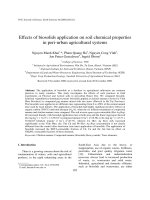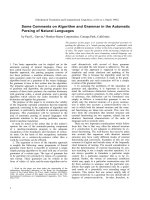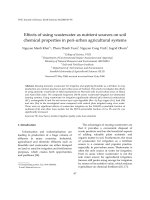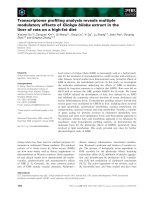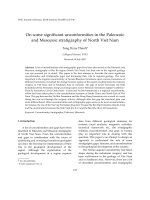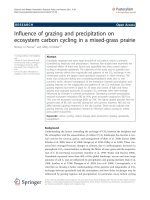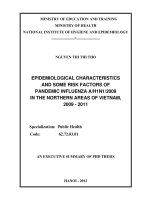precipitation effects on soil carbon cycling in the sonoran desert
Bạn đang xem bản rút gọn của tài liệu. Xem và tải ngay bản đầy đủ của tài liệu tại đây (862.95 KB, 201 trang )
PRECIPITATION EFFECTS ON SOIL CARBON CYCLING IN THE SONORAN
DESERT
by
Jessica Marie Cable
___________
A Dissertation Submitted to the Faculty of the
DEPARTMENT OF ECOLOGY AND EVOLUTIONARY BIOLOGY
In Partial Fulfillment of the Requirements for the Degree of
DOCTOR OF PHILOSOPHY
In the Graduate College
THE UNIVERSITY OF ARIZONA
2006
UMI Number: 3208062
3208062
2006
UMI Microform
Copyright
All rights reserved. This microform edition is protected against
unauthorized copying under Title 17, United States Code.
ProQuest Information and Learning Company
300 North Zeeb Road
P.O. Box 1346
Ann Arbor, MI 48106-1346
by ProQuest Information and Learning Company.
2
THE UNIVERSITY OF ARIZONA
GRADUATE COLLEGE
As members of the Dissertation Committee, we certify that we have read the dissertation
prepared by Jessica Marie Cable entitled “Precipitation Effects on Soil Carbon Cycling in
the Sonoran Desert” and recommend that it be accepted as fulfilling the dissertation
requirement for the Degree of Doctor of Philosophy.
_______________________________________________________________________ Date: 4-7-2006
Travis E. Huxman
_______________________________________________________________________ Date: 4-7-2006
Brian J. Enquist
_______________________________________________________________________ Date: 4-7-2006
Robert Robichaux
_______________________________________________________________________ Date: 4-7-2006
Alfredo Huete
_______________________________________________________________________ Date: 4-7-2006
Russell L. Scott
Final approval and acceptance of this dissertation is contingent upon the candidate’s
submission of the final copies of the dissertation to the Graduate College.
I hereby certify that I have read this dissertation prepared under my direction and
recommend that it be accepted as fulfilling the dissertation requirement.
________________________________________________ Date: 4-7-2006_____
Dissertation Director: Travis E. Huxman
3
STATEMENT BY AUTHOR
This dissertation has been submitted in partial fulfillment of requirements for an
advanced degree at The University of Arizona and is deposited in the University Library
to be made available to borrowers under rules of the Library.
Brief quotations from this dissertation are allowable without special permission,
provided that accurate acknowledgement of source is made. Requests for permission for
extended quotation from or reproductions of this manuscript in whole or in part may be
granted by the copyright holder.
Signed: Jessica M. Cable
4
ACKNOWLEDGEMENTS
I am grateful to the following people that supported my research and professional
development: my husband, Bill Cable; my parents, Jane Young and Dr. David T. Young;
my faithful hound, Pete; members of my dissertation committee, collaborators, and peers;
Dr. Kiona Ogle, Dr. David Williams, Dr. David Tissue, Dr. Scott Saleska, Joost Van
Heran, Enrico Yepez-Gonzalez, and Dr. Keirith Snyder.
The following organizations and institutions provided material and financial
support during my doctoral research: The Institute for the Study of Planet Earth; The
University of Arizona Department of Ecology and Evolutionary Biology; the United
States Department of Agriculture – Agricultural Research Center; SAHRA
(Sustainability of semi-Arid Hydrology and Riparian Areas); NCEAS - PrecipNet
(National Center for Ecological Analysis and Synthesis); CATTS, NSF GK-12 science
outreach fellowship; BASIN (Biosphere-Atmosphere Stable Isotope Network);
International Arid Lands Consortium; and NSF Division of Environmental Biology.
5
DEDICATION
I am grateful to my husband Bill, who through late nights, warm meals, and unmatched
technical expertise, has supported and encouraged me. I could not have done this without
you, and I would split this PhD with you if it were permitted.
6
TABLE OF CONTENTS
LIST OF FIGURES……………………………………………………………………….9
LIST OF TABLES……………………………………………………………………….11
ABSTRACT…………………………………………………………………………… 12
INTRODUCTION……………………………………………………………………….14
PRESENT STUDY………………………………………………………………………21
REFERENCES………………………………………………………………………… 33
APPENDIX A: PRECIPITATION PULSE SIZE EFFECTS ON SONORAN DESERT
SOIL MICROBIAL CRUSTS………………………………………………………… 43
Abstract……………………………………………………………………………… 44
Introduction……………………………………………………………………………45
Materials and methods ……………………………………………………………… 48
Results…………………………………………………………………………………57
Discussion…………………………………………………………………………… 59
Acknowledgements……………………………………………………………………63
References…………………………………………………… …………………… .64
Figure legends…………………………………………………………………………71
Figures……………………………………………………………………………… 73
APPENDIX B: SOIL RESPIRATION RESPONSE TO PRECIPITATION: THE
EFFECTS OF GRASS AND SOIL SURFACE ON SOIL MOISTURE……………… 78
Abstract……………………………………………………………………………… 79
7
TABLE OF CONTENTS - continued
Introduction……………………………………………………………………… ….80
Methods……………………………………………………………………………… 84
Results…………………………………………………………………………… ….88
Discussion…………………………………………………………………………… 93
Acknowledgements…………………………………………………………… ……102
Literature cited……………………………………………………………………….103
Tables……………………………………………………………………………… 114
Figure legends……………………………………………………………………… 116
Figures…………………………………………………………………………… …119
APPENDIX C: EFFECTS OF PRECIPITATION PULSE SEQUENCING ON PLANT
AND SOIL RESPONSE TO PRECIPITATION PULSE SIZE IN THE SONORAN
DESERT……………………………………………………………………………… 125
Abstract………………………………………………………………………….… 126
Introduction………………………………………………………………………… 127
Methods………………………………………………………………………… … 130
Results……………………………………………………………………….……….133
Discussion………………………………………………………………… ……… 137
Acknowledgements………………………………………………………………… 143
Literature cited……………………………………………………………………….144
Figure legends……………………………………………………………………… 153
Figures…………………………………………………………………… …………156
8
TABLE OF CONTENTS - continued
APPENDIX D: PRECIPITATION EFFECTS ON SOIL RESPIRATOIN IN SEMI-ARID
ECOSYSTEMS: THE ROLE OF WOODY PLANT
ENCROACHMENT………………………………………………………………… 164
Abstract………………………………………………………………………………165
Introduction……………………………………………………………………….….166
Methods………………………………………………………………………………169
Results…………………………………………………….………………………….172
Discussion……………………………………………………………… ………… 175
Acknowledgements…………………………………………………… ……………179
Literature cited……………………………………………………………………….180
Tables…………………………………………………………………………… …188
Figure legends……………………………………………………………………… 189
Figures……………………………………………………………………………….191
APPENDIX E: PERMISSION FROM JOURNAL… ……………………………… 195
Journal cover page……… ………………………………………………………….197
9
LIST OF FIGURES
APPENDIX A: PRECIPITATION PULSE SIZE EFFECTS ON SONORAN DESERT
SOIL MICROBIAL CRUSTS
FIGURE 1, Crust CO
2
flux response to water application……………………………73
FIGURE 2, Keeling plot intercepts for different watering treatments…….……… 74
FIGURE 3, Carbon pool isotope values………………………………………………75
FIGURE 4, Percent carbon contributed to CO
2
flux from crust and soil…………… 76
FIGURE 5, Precipitation size distribution across 3 deserts………………………… 77
APPENDIX B: SOIL RESPIRATION RESPONSE TO PRECIPITATION: THE
EFFECTS OF GRASS AND SOIL SURFACE ON SOIL MOISTURE
FIGURE 1, Effects of a large pulse after prolonged drought on respiration, soil
moisture, and soil temperature……………………………………………………119
FIGURE 2, Effects of pulse size and initial soil moisture on respiration, soil
temperature, soil moisture, and soil temperature and moisture effects on
respiration…………………………………………………………………………120
FIGURE 3, Effects of pulse history and a large pulse after prolonged drought on
respiration, soil moisture, and soil temperature………………………………… 121
FIGURE 4, Effects of pulse size, initial soil moisture, and pulse history on respiration,
soil temperature, soil moisture, and soil temperature and moisture effects on
respiration…………………………………………………………………………122
FIGURE 5, Relationship between initial respiration rate and respiration responsiveness
to rainfall………………………………………………………………………….123
10
LIST OF FIGURES - continued
FIGURE 6, Relationship between cumulative carbon loss and mean soil
moisture………………………………………………………………………… 124
APPENDIX C: EFFECTS OF PRECIPITATION PULSE SEQUENCING ON PLANT
AND SOIL RESPONSE TO PRECIPITATION PULSE SIZE IN THE SONORAN
DESERT
FIGURE 1, Soil moisture over time…………………………………………… … 156
FIGURE 2, Soil respiration at 4am over time………………………………… ….157
FIGURE 3, Effect of soil moisture and temperature on soil respiration………… 158
FIGURE 4, Leaf water potential over time…………………………………….…….159
FIGURE 5, Leaf respiration over time………………………………… ………….160
FIGURE 6, Photosynthesis at 2pm over time……………………………………… 161
FIGURE 7, Peak day photosynthesis at 2pm comparison………………………… 162
FIGURE 8, Rhizosphere respiration over time………………………………………163
APPENDIX D: PRECIPITATION EFFECTS ON SOIL RESPIRATOIN IN SEMI-ARID
ECOSYSTEMS: THE ROLE OF WOODY PLANT ENCROACHMENT
FIGURE 1, Summer precipitation, soil moisture, and respiration from five
microsites………………………………………………………………………….191
FIGURE 2, Relationship between respiration and soil moisture………….….….… 192
FIGURE 3, In situ CO
2
measurements and incubations of soil at 35°C… … …….193
FIGURE 4, Q
10
for respiration in dry and wet soil………………………………… 194
11
LIST OF TABLES
APPENDIX C: EFFECTS OF PRECIPITATION PULSE SEQUENCING ON PLANT
AND SOIL RESPONSE TO PRECIPITATION PULSE SIZE IN THE SONORAN
DESERT
TABLE 1, Statistical analyses of Experiments in June 2002 and 2003…………… 114
TABLE 2, Statistical analyses of Experiments in August 2002 and 2003…… … 115
APPENDIX B: SOIL RESPIRATION RESPONSE TO PRECIPITATION: THE
EFFECTS OF GRASS AND SOIL SURFACE ON SOIL MOISTURE
TABLE 1, Statistical analysis of the relationship between soil moisture and
respiration…………………………………………………….………………… 188
12
ABSTRACT
Biological activity in desert soils is driven by water availability. The nature of
individual precipitation events is critical to understanding soil moisture availability. Rain
falls as discrete events (pulses) that vary in size and sequencing, resulting in soil “wet-dry
cycles”. Soil organisms are responsive to wet-dry cycles with rapid changes in activity.
How soil activity is driven by changes in water content associated with individual pulses
is poorly understood. The effects of precipitation on soil processes likely depend on
ecosystem structure, which influences the soil environment. The goal of this dissertation
was to determine how soil carbon cycling responds to precipitation in the context of
ecosystem structure (plant composition, geomorphology) and climate.
I used differences in stable carbon isotopic composition of soil organisms and
plants to understand how positioning in the soil profile influences biological responses to
different sized pulses. I evaluated how soil texture and grass species composition affect
soil process response to rainfall in different seasons. I manipulated rainfall sequence to
understand the interaction between closely spaced rainfall events of different sizes on soil
processes. I evaluated the role of plant functional types in influencing soil microclimate
and litter deposition and the response of soil processes to seasonal rainfall.
Chamber measurements of soil and plant CO
2
flux were used to understand their
response to rainfall. I found that surface organisms are more responsive to small rainfall
events due to the relationship between pulse size and infiltration. While soil texture and
season of rainfall are important, the best predictor of the response of soil respiration to
rainfall was initial activity levels. Grass species was not important. Grass roots and soil
13
microbes differ in response to sequences of precipitation. Grasses responded less to
subsequent large events if they were already ‘activated’ by a recent rainfall event. The
effect of plant functional type was size dependent with differences occurring only with
large shrubs. This work suggests that large scale simulations of soil carbon cycling in
deserts should carefully consider wet-dry transitions in the context of plant functional
type and initial soil condition in order to predict the responses to global change.
14
INTRODUCTION
Water limited regions and precipitation patterns
Rising atmospheric CO
2
concentrations have consequences for the climate
system, due to the effect on global temperatures (Stouffer et al. 1994, Keeling et al. 1995,
Sellers et al. 1996, Petit et al. 1999). In the past century, mean global air temperature has
increased 0.5°C and it is expected to continue rising (Stouffer et al. 1994, Easterling et al.
2000, Moraes et al. 2005), likely resulting in amplification of the global water cycle,
changing regional patterns of precipitation and extreme events (Keeling et al. 1995, Liang
et al. 1995, Easterling et al. 2000, Dai et al. 2001, Houghton 2005). Effects of altered
precipitation on terrestrial ecosystems appear to be biome-specific, with arid and semi-
arid regions being quite responsive (Yu and Neil 1993, Giorgi et al. 1994, Smith et al.
2000, Huxman et al. 2004c). Predictions of rainfall change on an annual or seasonal
time-scale are not sufficient to determine the impacts on ecosystem processes in arid and
semi-arid ecosystems (Weltzin et al. 2003, Loik et al. 2004). It is more important to
determine how precipitation may change on nested time scales (e.g. – daily and seasonal)
and at fairly small spatial scales in order to predict the response of terrestrial ecosystems
(Yu and Neil 1993, Liang et al. 1995, Meehl et al. 2000, Weltzin et al. 2003, Loik et al.
2004).
In arid and semi-arid regions, rainfall occurs as discrete events or “pulses”
because the timing of storms relative to evaporative demand results in significant periods
of low water availability in soils (Noy-Meir 1973, Weltzin et al. 2003). In the upper
15
Sonoran Desert, 50 to 60% of rainfall occurs in the summer as part of the North
American Monsoon (Adams and Comrie 1997). High air temperatures and low
atmospheric water vapor contents during this period cause soil to rapidly dry between
storms, resulting in elevated soil moisture only in the immediate days following a rain
event, limiting the access of organisms to resources that may be available in the soil or
maintaining them in periods of dormancy (Noy-Meir 1973, Weltzin et al. 2003, Huxman
et al. 2004b). Pulses of precipitation vary in magnitude and timing, altering the depth of
water infiltration and the duration of high soil moisture (Weltzin et al. 2003, Schwinning
and Sala 2004). Variation in soil moisture often results in a non-linear response of
ecosystem processes, such as CO
2
exchange, due to the differential activation of
organisms distributed throughout the soil profile (Huxman et al. 2004b, Schwinning et al.
2004). Combining our understanding of the spatial distribution of organisms in an
ecosystem with the time-depth distribution of soil moisture that derives from rainfall
events provides an important paradigm for understanding the controls over ecosystem
function in arid and semi-arid ecosystems.
The spatial distribution of plants species or functional types may determine how
they influence ecosystem processes in response to a pulse of precipitation, due to
differences in photosynthetic capacity, phenology, canopy structure, and litter deposition
dynamics (Fierer et al. 2003, Huxman et al. 2004a, Huxman et al. 2004b, Scott et al.
2006, Ignace et al. in prep). For example, the ratio of woody to herbaceous plants affects
the spatial pattern of soil resources and energy, as a result of differential soil shading and
litter accumulation under shrub canopies (Garcia-Moya and McKell 1969, Schlesinger et
16
al. 1996, Paruelo and Lauentroth 1996, Schlesinger and Pilmanis 1998, Cross and
Schlesinger 1999). The spatial pattern of these features likely influences the potential
activity of microbial components of the soil systems, which in turn would affect
decomposition, nitrogen mineralization / immobilization and soil carbon cycling. These
effects on ecosystem processes occur in addition to the direct effects plants have on
ecosystem processes by their own physiological processes.
Variation in ecosystem processes across a landscape may be influenced by soil
properties because soils in water limited landscapes influence many biological and
physical processes (McAuliffe 1994). Through altering water infiltration and retention,
soil texture can impact the response of different ecosystem components to a pulse of
precipitation (Huxman et al. 2004a). For example, fine textured soil has higher potential
for microbial activity due to higher moisture retention capacity and organic matter
content (Austin et al. 2004), but infiltration rates on these soil types are relatively slow,
affecting the potential amplitude of soil moisture peaks following rain and the
characteristics of wet-dry cycles. Soil texture additionally affects aspects of ecosystem
structure, including the establishment, composition, and activity of plants (Noy-Meir
1973, McAuliffe 1994, 1999, 2003, Parker 1995, Smith et al. 1995, Hamerlynck et al.
2002, Huxman et al. 2004a, Thomas and Dougill 2006).
Carbon cycling, soils and precipitation change
One of the most important contributors to variation in the global annual CO
2
cycle
is the effect of short-term changes in climate on ecosystem carbon cycling (Houghton
17
2000). The response of ecosystem processes, such as the biological exchange of CO
2
, to
precipitation is important to quantify because of the climatic sensitivity of photosynthesis
and respiration and the potential of ecosystems to feedback to climate (Grogan et al.
2001, Huxman et al. 2004a, Li et al. 2004, Loik et al. 2004, Scott et al. 2006). As a major
contributor to ecosystem CO
2
exchange, soil respiration is the efflux of CO
2
from the
activity of microbes (defined as free-living heterotrophic micro-organisms) and the
rhizosphere (defined here as the activity of plant roots and their closely associated
microorganisms). In non-water limited ecosystems, soil respiration is modeled as a
temperature response from first order kinetics (Lloyd and Taylor 1994). However where
soils are ephemerally wet, water inputs may be an overriding driver of biological activity
in soils (Borken et al. 1999, Davidson et al. 2000, Austin et al. 2004).
The rapid increase of CO
2
from soils following the application of water has been
documented, and attributed to changes in microbial biomass, rapid upregulation of
physiological processes associated with carbon and nitrogen cycling, and differences in
the sensitivity of microbial species to water status (Rochette et al. 1991, Schimel et al.
1999, Franzluebbers et al. 2000, Fierer and Schimel 2003, Austin et al. 2004, Huxman et
al. 2004a Saetre and Stark 2005). Through soil-water films, soil moisture controls
availability of nutrients and labile carbon, which may alter the role of soil texture and the
response of respiration to temperature (Skopp et al. 1990, Davidson et al. 2006). Soil
moisture indirectly affects substrate supply through promoting plant production of labile
carbon from plant litter, fine roots, and root exudates (Raich and Schlesinger 1992, Raich
et al. 2002, Townsend et al. 1997, Trumbore 2000, Janssens et al. 2001) and by altering
18
the delivery of resources in the soil solution to different microsites (Heffernan and
Sponseller 2004, Agehara and Warncke 2005). However how the direct and indirect
effects of moisture interact with temperature following rainfall is poorly understood
(Lloyd and Taylor 1994, Borken et al. 1999, Conant et al. 1998, Conant et al. 2004).
Although much of the CO
2
efflux from soils after a rain event is hypothesized to
be from microbial activity, autotrophic / rhizosphere respiration can be nearly 50% of
total soil respiration (Bowden et al. 1993, Andrews et al. 1999, Tang and Baldocchi
2005). Nearly 12% of recent photosynthate is respired in the rhizosphere (Nguyen 2003),
representing a major allocation sink for plant carbon. In contrast to heterotrophic
microbial activity, rhizosphere activity is indirectly controlled by factors that influence
photosynthesis, such as light, temperature, moisture, and nutrients (Son et al. 2004, Irvine
et al. 2005). The direct effect of water is likely through nutrient availability and
relaxation of plant water stress (Huang and Fu 2000, DaCosta et al. 2004, Peek et al.
2005, Irvine et al. 2005). The responses of both rhizosphere and heterotrophic activity to
precipitation depend on the location in the soil profile, where small rain events may
activate only surface organisms, but larger rainfall events influence organisms deeper in
the soil profile (Huxman et al. 2004b). Partitioning the responses of heterotrophic
microbes and rhizosphere to precipitation would aid in our mechanistic understanding of
how water controls biological activity in large portions of the terrestrial globe.
The effects of water on respiration have been primarily explored in laboratory
settings (Orchard and Cook 1983, Fierer and Schimel 2003, Conant et al. 1998, Conant et
al. 2004). This work has been instrumental in evaluating microbial population dynamics,
19
nutrient mineralization, and the effects of multiple wet-dry cycles on these processes. In
situ measurements of the response to rainfall are increasing (e.g. Amundson et al. 1989,
Liu et al. 2002), but there is a surprising lack of data from many biome types, including
those in arid and semi-arid regions. Many questions persist, such as: what is the response
of rhizosphere respiration to a pulse, what is the impact of single vs. multiple rainfall
events on soil respiration, and how does ecosystem structure affect soil carbon cycling
processes following rainfall?
This dissertation contributes to an understanding how soils contribute to
ecosystem function in response to rainfall in semi-arid regions. The contributions of CO
2
to whole ecosystem exchange from both the rhizosphere and heterotrophic microbes are
quantified by using flux-chamber based and isotopic techniques. By measuring the
precipitation response of soils across plant communities, soil types, microclimate
gradients, and across seasons, this dissertation evaluates how complexities of the
environment affect carbon cycling in soils at different temporal scales. A primary goal of
this research is to generate data to be used in predictive modeling exercises of soil
respiration in water limited ecosystems and to determine how potential climate changes
affect carbon cycling through altered precipitation regimes.
Short-term threshold processes, such as the rewetting of dry soil associated with
individual rainfall events, represent a major challenge for the current suite of equilibrium
models used to understanding how climate change and variability influence ecosystem
processes (Groffman & Tiedje 1988; Davidson et al., 1993; Cabrera et al., 2005; Weltzin
et al., 2003). Many of these models evaluate soil respiration as primarily a function of
20
temperature (Lloyd and Taylor 1994, Frank et al. 2002), and a few use moisture indices
to incorporate the effects of soil moisture (Bunnell and Tait 1974, O’Connell 1990,
Pumpanen et al. 2003), substrate chemistry (Bunnell et al. 1977, Schimel and Weintraub
2003), and oxygen availability (Bunnell and Tait 1974). The models rarely consider the
co-variation of water, temperature and temperature extremes or the importance of
antecedent conditions and rainfall sequencing. Most models are also limited to microbial
respiration from decomposition (but see Pumpanen et al. 2003), but rhizosphere
respiration is an important contributor to ecosystem CO
2
efflux. These models perform
poorly in environments with dynamic wet-dry soil cycles with conditions ranging from
saturated and anoxic to dry (Bunnell and Tait 1974, O’Connell 1990). Additionally, the
temperature relationship commonly used in models (Lloyd and Taylor 1994, Pumpanen
et al. 2003) does not adjust with high or low temperatures, so the predictions may break
down in extreme temperature environments, such as arid and semi-arid ecosystems.
Thus, there is a significant need for concurrent measurements of soil moisture, soil
temperature, and soil respiration, and the role of precipitation pulse variation (eg- size,
history, sequence, and antecedent conditions) to properly develop models of soil
respiration in arid and semi-arid ecosystems.
21
PRESENT STUDY
The methods, results and conclusions of this research program are presented in
manuscript form, appended to this dissertation. The following is a description and
summary of the most important findings in these documents.
PRECIPITATION PULSE SIZE EFFECTS ON SONORAN DESERT SOIL
MICROBIAL CRUSTS
(This work has been published: Cable JM and Huxman TE (2004) Precipitation pulse
size effects on Sonoran Desert soil microbial crusts. Oecologia 141(2): 317-324; and has
been included in this dissertation in Appendix A with kind permission of Springer
Science and Business Media.)
Arid and semi-arid regions have large areas of unvegetated space due to the
spatial and temporal heterogeneity of soil water and constraints on plant establishment
(Noy Meir 1973, Ehleringer 1985, Smith and Nowak 1990, Smith et al.1997). These
large expanses of unvegetated space are not devoid of autotrophic activity due to the
presence of microbial crust communities (Belnap 2003). These assemblages of lichen,
algae, moss, fungi, cyanobacteria, and bacteria can occupy up to 70% of intercanopy
space, and are found on the surface of all deserts around the world (Belnap 2001). Their
activity is directly linked to periods following rain events when soil surface moisture is
high (Lange 2001), but they are quiescent during dry inter-rainfall periods (Lange et al.
1986). These groups of organisms appear to have an important role in the stability of
ecosystem structure in arid landscapes but the role of crusts in ecosystem carbon cycling
22
is unclear (Belnap 2003). Due to their extensive coverage and frequency with which they
experience precipitation, crusts may have a significant influence on ecosystem level
production.
The objective of this study was to determine how the stratification of organisms in
the soil affects the response of soils to precipitation pulse size. Because rainfall event
size affects water infiltration depth (larger events infiltrate to greater depths), crusts and
sub-surface microbial communities and plants may differentially respond to precipitation
events of different sizes. Crusts may be activated by essentially any rainfall event, while
relatively large pulses are required to activate plants and soil microbes (Huxman et al.
2004b). The questions addressed in this study are: what are the photosynthetic and
respiratory responses of crusts to a precipitation pulse? What is the contribution of soil
microbial crusts to the efflux of CO
2
from soils, relative to the respiration derived from
other soil micro-organisms and plant roots? How does this relative contribution change
as a function of precipitation pulse size?
This work was carried out in pots and in situ in the Sonoran Desert. Following a
single water application, diurnal measurements of gas exchange were made to
characterize CO
2
exchange response through time. Following water application
simulating two pulse sizes, respired CO
2
was collected and Keeling plots and mixing
model analyses were done to determine the dominant contributor to ecosystem
respiration. The Keeling plot technique has been used in several studies to partition
respiration into its sources (Rochette et al. 1999, Bowling et al. 2001).
23
I found that at ambient conditions, CO
2
effluxes from soils were small and crusts
contributed more than the two remaining belowground components to total flux.
However, this approximated 50% from the crust and remaining soil components. I
hypothesized that small events would activate only surface organisms and large events
would activate deeper organisms. I found that following a 2 mm pulse, crusts dominated
the respiratory CO
2
efflux, while following a 25.4 mm pulse, heterotrophic soil microbial
communities and roots dominated the efflux. The small pulse did not infiltrate to depth
and evaporated quickly only activating the crust and leaving the plant roots and soil
microbes dormant. The large event infiltrated to depth and activated each component.
As such, the contribution of different ecosystem components to ecosystem carbon cycling
is pulse size dependent due to the different locations of these components into the soil
profile.
The majority of rainfall events in the Sonoran, Chihuahuan, and Mojave Deserts
are small pulse events (<2mm). Therefore, the contribution of crusts to ecosystem CO
2
exchange and productivity may be large (Jasoni et al., 2005). In pulse driven ecosystems,
the size of the rainfall events appear to be important in determining which components
are active and to what degree. Soil respiration, that is respiration from soil microbes,
roots, and crusts if present, represents one of the largest components of the local carbon
cycle contributing to the global carbon budget (Rustad et al. 2000). Soil moisture is a
controller of soil respiration so a change in precipitation regimes, as predicted from
climate change models, in a pulse driven ecosystem may alter respiratory responses from
the soil as a whole (Rustad et al. 2000; Easterling et al. 2000). However, as suggested in
24
this study, a change in precipitation patterns such as a trend toward more frequent events
of large or small pulses may alter the respiratory contribution from different components
of the ecosystem, thereby altering the carbon budget of desert ecosystems and the relative
importance of crusts.
SOIL CO
2
EFFLUX RESPONSE TO PRECIPITATION: THE EFFECTS OF
GRASS AND SOIL SURFACE ON RESPIRATION
(The methods, results, and conclusions of this study are presented in the paper appended
to this dissertation in Appendix B. The following is a summary of the most important
findings in this document. This paper will be submitted to Plant and Soil for
publication.)
Pulses of precipitation characterize rainfall in deserts (Noy-Meir 1973). The
response of ecosystem processes, such as soil respiration from microbes and autotrophs,
to pulses is controlled primarily by soil moisture (Orchard and Cook 1983; Liu et al.,
2002; Fierer and Schimel 2003; Conant et al., 2004). Temporal and spatial variation in
soil moisture is driven by characteristics of rainfall, such as seasonal timing, frequency,
magnitude, and inter-annual variation, along with ecosystem factors, such as soil texture
and plant species (Austin et al., 2004; Huxman et al., 2004). The magnitude and duration
of soil respiratory activity is influenced by a number of features that impact the
“biological effectiveness” of a pulse, including: seasonal precipitation affects initial soil
moisture; inter-annual variation in pulses (pulse history) influencing soil resources; soil
texture alters water infiltration and retention; and plants alters soil microclimate.

